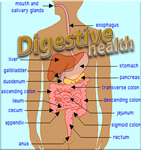DIGESTIVE HEALTH | THE BODY’S OPERATING SYSTEM
Support for Your Body Naturally…
Is your stomach the only organ involved
 in the digestion of your food?
in the digestion of your food? The answer is no. The human digestive system is a complex series of organs and glands that process food. In order to use the food we eat, our body has to break the food down into smaller molecules that it can process; it also has to excrete waste.
Food provides us with fuel to live, energy to be active, and the raw materials to build new cells. All the different varieties of food we eat are broken down by our digestive system and transported to every part of our body by our circulatory system.
How the Digestive System Works
Our digestive system is an approximately 30 foot long tube. The digestive process begins in the mouth, where the teeth and tongue break up the food after it has been softened with saliva. The food is then swallowed and travels down the esophagus to the stomach.
While the food is in the stomach, it is mixed with a mild acid which breaks the food down into a paste similar to porridge, called Chyme. The food then passes, a little at a time, into the small intestine, which is roughly 18 feet long. Here the food is broken down even further until it is small enough to pass through the walls of the small intestine into the bloodstream. Food that cannot be digested passes into the large intestine, where the water and minerals are absorbed into the blood stream. The solid waste is then expelled from the body. The digestive tract also functions as an immune organ, serving as a protective barrier to ingested toxins, allergens, and pathogens (bacteria, parasites, viruses, and fungi) that could otherwise cause disease.
Parts of the Digestive System
- The Mouth: The process of digestion begins with chewing. Chewing breaks up food into smaller pieces that can be swallowed without choking. The salivary glands secrete a mucous solution into the mouth that moistens and lubricates food particles. Saliva contains amylase, an enzyme that begins to digest carbohydrates. As food particles begin to dissolve, they react with the chemoreceptors in the mouth, giving rise to the sensation of taste.
- Esophagus: Once food is in the esophagus, involuntary muscle contractions called peristalsis push it toward the stomach. At the end of the esophagus, the lower esophageal sphincter lets the food into the stomach. It opens and then quickly closes to keep the food from escaping back into the esophagus.
- Stomach: In the stomach, the food begins its preparation for the small intestine. Glands in the stomach secrete acid, enzymes and a mucous that coats and protects the stomach from its own acids and prevents ulcers. The stomach's smooth muscles contract about every 20 seconds, stirring up the acid and enzymes and turning your food into chyme. But some foods just can't be reduced to chyme and remain a pasty, solid substance that is released into the small intestine in a process that takes more than an hour. Some food, however, can be out of the stomach in a mere 20 minutes.
- Duodenum: Your now unidentifiable food squirts into the duodenum, the first part of the small intestine. The breakdown process continues with enzymes from the pancreas and bile from the liver. Again, peristalsis helps mix up these juices. The next small intestine section is the coiled jejunum, followed by the ileum, which leads straight to the large intestine. These two sections absorb nutrients and water more than they break down food.
- Small Intestine: The small intestine has a smaller circumference than the large intestine, but it's actually the longer of the two sections -- it has the surface area of a tennis court! You may wonder how all this fits into your body. The answer is simple: The surface of the small intestine has many tight folds that can absorb nutrients and water -- they greatly increase the surface area. These folds are covered with villi, or tiny projections that have even smaller microvilli on them. Villi and microvilli have affinities for specific nutrients. That means that several different kinds of villi will grab the nutrients, electrolytes and dietary molecules in your food (for example carbohydrates, protein, sodium, calcium, and vitamins.). The absorbed nutrients move through the wall of the intestines and into blood vessels that take them throughout the body.
- Large Intestine: Once all the nutrients are extracted from the food, the indigestible parts are transported into the large intestine. The large intestine absorbs extra fluid to produce solid waste. To move the waste, the colon uses the same involuntary muscular movements called peristalsis. Unlike the stomach and small intestines, though, whose movements take a matter of hours, it takes days for waste to move through the large intestine. The waste moves at a pace of about 1/3 of an inch per hour. The large intestine is often referred to as the colon.
- Colon: Also known as the large intestines, the colon has four sections: ascending, transverse, descending and sigmoid. In the first two sections, salts and fluids are absorbed from the indigestible food. Billions of bacteria that normally live in the colon help to ferment and absorb substances like fiber. While these tracts absorb, they also produce mucus that helps the solid waste move easily through the descending colon and into the third part of the large intestine, through the sigmoid section and finally on to the rectum where the fecal matter is stored before it leaves the body.
Natural Digestive Support Products
In Health,
Naturally Botanicals Team

This natural antibiotic increases our ability to produce antimicrobial action against the pathogens in the food we eat, the air we breath, and the things we come in contact with.
ReplyDeleteHerbs